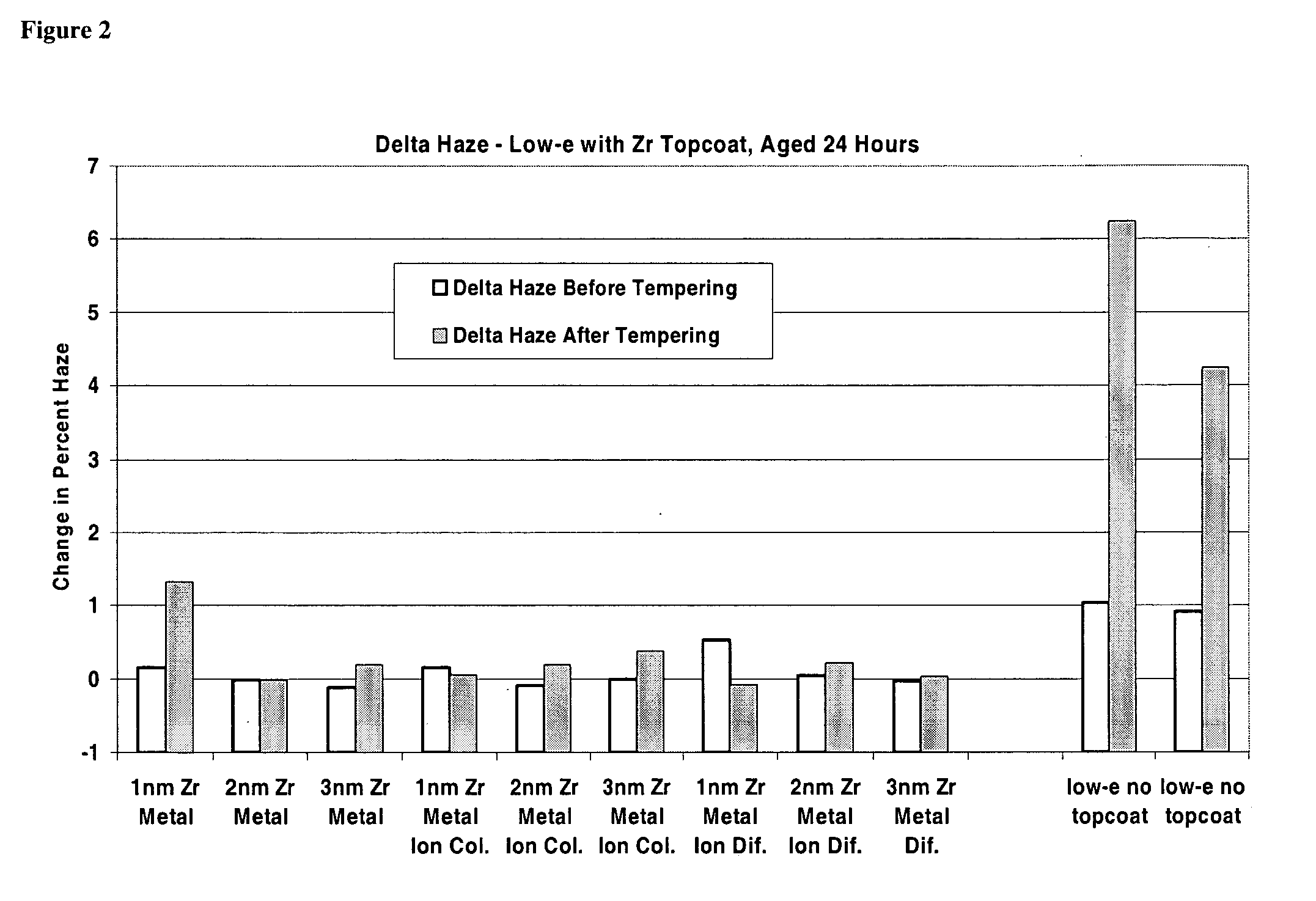Air oxidizable scratch resistant protective layer for optical coatings
a protective layer and scratch-resistant technology, applied in the field of outer scratch-resistant protective layers, can solve the problems of frequent damage to optical coatings, high scratching rate of optical coatings, and high scratching rate of metal thin film layers, so as to reduce the damage of scratching damage and ensure the hardness and durability. , the effect of sufficient hardness
- Summary
- Abstract
- Description
- Claims
- Application Information
AI Technical Summary
Benefits of technology
Problems solved by technology
Method used
Image
Examples
example 1
[0071] A low-e structure shown in FIG. 1 is sputtered with an outermost dielectric of silicon nitride. As a last coating step in the vacuum coater, a layer of 2 nm of Zr is deposited on the silicon nitride. The Zr layer oxidizes in air over a period of one week and the transmission of the low-e structure reaches a level within 0.5% of the same non-topcoated low-e.
example 2
[0072] A low-e structure shown in FIG. 1 is sputtered with an outermost dielectric of silicon nitride. As a last coating step in the vacuum coater, a layer of 2.5 nm of Zr is deposited on the silicon nitride. A further oxidation step is carried out in the vacuum coater where the Zr layer is exposed to an oxygen containing plasma. The Zr layer further oxidizes in air over a period of one week and the transmission of the low-e structure reaches a level within 0.5% of the same non-topcoated low-e.
Experimental Procedure:
[0073] Coating setup—Samples were sputter coated using a 1 meter wide Twin-Mag target with Zr targets. Power was AC supplied by a Huttinger BIG 100.
[0074] Samples were sputtered under three different atmospheres: [0075] 1. Argon only to deposit a metal layer. [0076] 2. Addition of small amount (10 sccm) O2 to create oxygen doped Zr. The layer was still substantially metallic. Material is signified in the data as ZrOx. [0077] 3. Addition of small amount (10 sccm) N2 t...
example 3
[0093] Scratch data for low-e stacks with and without topcoats is presented in the table below. The ZrSi topcoat in this case is a co-sputtered layer done on a Twin-Mag where one side of the magnetron is setup with a Zr target and the other side is setup with a Si10wt % Al target. The sputtering of the topcoat is done in an argon atmosphere. Sputtering power was equal on both targets. The resulting topcoats were about 3 nm thick.
[0094] The scratch test was the 200 stroke Scotch-Brite mechanical durability test. In this case the scratch damage on all samples was too low to detect by haze measurements. The quantification was done by a direct count of scratches on the coated surface.
[0095] The counts were carried out by counting all visible scratches across the path of the Scotch-Brite pad path. Counts were taken in three places; one in the center and 1.5 inches to either side of center of the scratched sample. The scratched samples were 4″×6″. The Zr and ZrSi topcoats both provided ...
PUM
| Property | Measurement | Unit |
|---|---|---|
| Time | aaaaa | aaaaa |
| Thickness | aaaaa | aaaaa |
| Nanoscale particle size | aaaaa | aaaaa |
Abstract
Description
Claims
Application Information
 Login to View More
Login to View More - R&D
- Intellectual Property
- Life Sciences
- Materials
- Tech Scout
- Unparalleled Data Quality
- Higher Quality Content
- 60% Fewer Hallucinations
Browse by: Latest US Patents, China's latest patents, Technical Efficacy Thesaurus, Application Domain, Technology Topic, Popular Technical Reports.
© 2025 PatSnap. All rights reserved.Legal|Privacy policy|Modern Slavery Act Transparency Statement|Sitemap|About US| Contact US: help@patsnap.com



